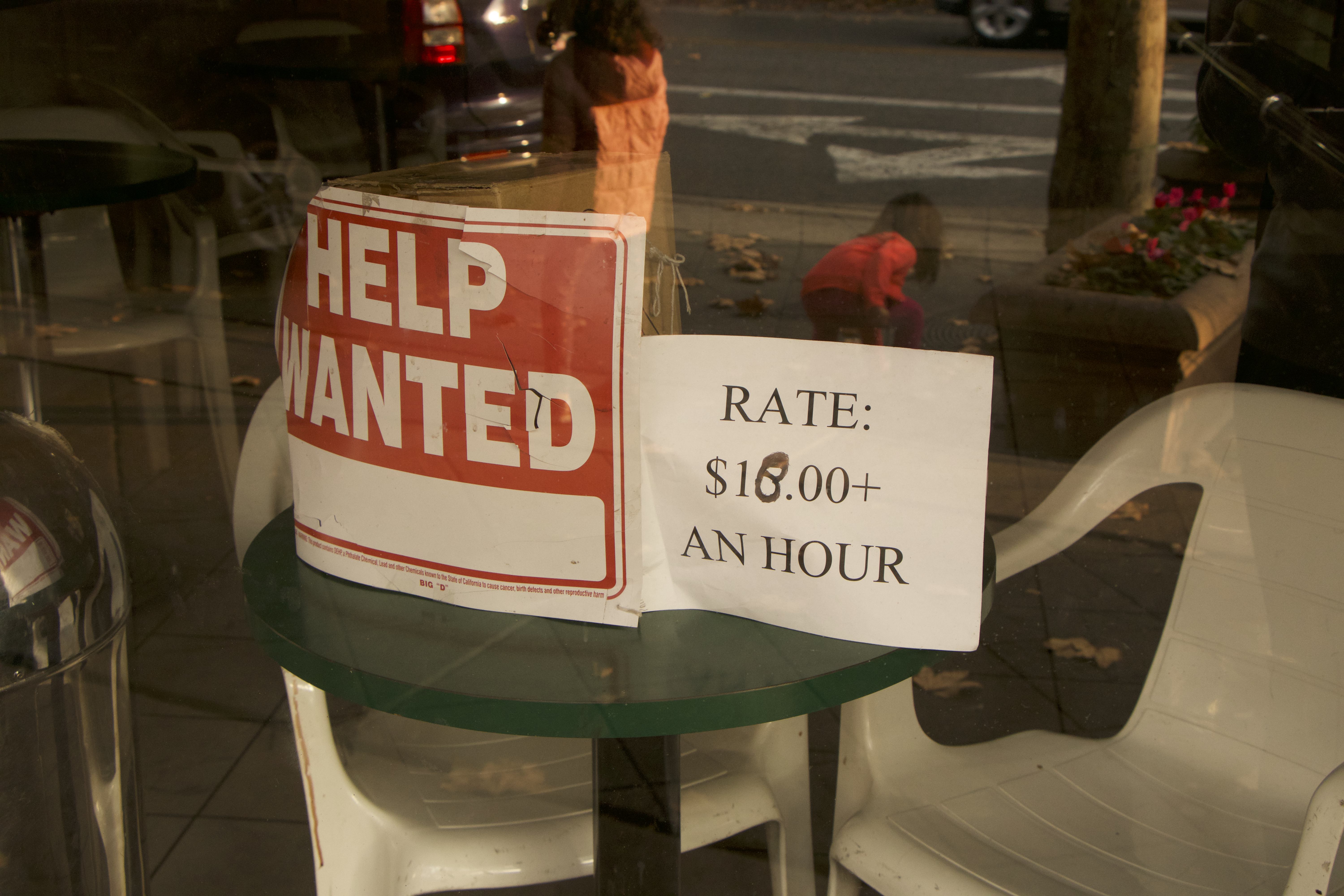One in two storefronts on the 200 block of Castro Street in downtown Mountain View bears a “Now Hiring” sign. Some posters are handwritten on sheets of printer paper, others professionally designed and printed, some hand-painted.
Recently Gelato Classico has remained closed most hours of the day with a “Help Wanted” sign sitting front and center in the shop window. The hourly rate has been crossed out with marker, the sign re-written to display the new going rate for serving up the frozen dessert sorbetto: “$18/hour.”
The Bay Area is plagued with a labor shortage, and it’s showing on the facades of downtown Mountain View’s businesses.

The shortage is impacting stores and restaurants to different degrees. Some small business owners on this block of Castro Street appear beleaguered with the stress of constantly hiring and feeling short-staffed, while others seem relatively unburdened by the shortage.
The Peninsula’s high cost of living and lack of affordable housing is making it increasingly difficult for local restaurant and retail workers to afford to live anywhere near their jobs. On top of that, the unemployment rate in Santa Clara County has dropped to an incredibly low 2.5 percent. The result is that businesses large and small are struggling to hire, and small businesses are now having to compete with large tech companies for high quality candidates looking for customer service roles.
But the City of Mountain View is working on strategies that help businesses to pay their employees at more competitive rates, including increasing the minimum wage to $15.65 effective January 1, one of the highest on the Peninsula. The city is also working on affordable housing initiatives to enable workers to live closer to their jobs. Meanwhile, small businesses are coping with the labor shortage by offering more attractive benefits to their staff and focusing on quality over quantity in their workforce.
Quality over quantity
Jing Chen is the co-owner of Therapy Stores, a local chain selling a variety of men’s and women’s clothing, gifts, home goods, and books. One of her stores sits on the same 200 block of Castro Street. She said in an interview that her work-ethic standards are high, so it’s always been challenging to hire quality staff that meet her expectations, but the problem intensified about three years ago.
Chen said she typically hires employees who are college-age, and many of them still live with their parents or have student loans that pay for housing, so she doesn’t attribute the shortage of quality candidates to the housing crisis.

Still, there’s something particular to the Bay Area that’s creating the shortage. Out of 11 Therapy locations, she said the only store that has been easy to hire for is their one store outside the Bay Area, in Portland, Oregon.
Instead, Chen blames the unemployment rate: in Santa Clara County it’s at 2.5 percent, the lowest it’s been since the 1970s. “Recently it’s more like no one’s really applying because in the recent year, there’s a lot more startups in Mountain View,” said Chen. With plenty of jobs available, and tech companies looking to hire both skilled and unskilled workers, she’s now competing with the tech industry for high quality candidates looking for sales and customer service roles.
The labor shortage survival playbook
Jon Andino has worked in the restaurant industry for 20 years. He and his business partner, Kayim Syed, opened Quality Bourbons and Barbecue (QBB) on Castro Street in the fall of 2017. He’s seen some of his neighbors struggle with hiring, but said that except for a few positions, he hasn’t had a problem staying fully staffed.
One of Andino’s advantages is his years of experience in the business. Between reaching out to people he has worked with previously, and getting referrals from his current employees, he’s built a solid team. But the QBB owners have also been strategic about the hours they open for business, working out optimal lunch and dinner hours for the restaurant, based on foot traffic downtown.
Andino also said he even downsized his team since opening his business last year, as he learned who were his star employees who could take over more responsibilities. This focus on quality over quantity, he said, has allowed him to do more with fewer staff and lessens the need to constantly be hiring more staff.
While Andino gets to make this choice to cut back on staff, other business owners are finding it difficult to hire either the quality or quantity of staff they need. Andrade of the Department of Economic Development said the result is typically that the owners themselves have to make up the difference by working even longer hours.
Therapy stores’ Chen also said having a small, but quality team is preferable to having a larger staff that don’t share her company culture, which prioritizes making personal connections with customers.
Her strategy for attracting dedicated, passionate employees, she said, is by showing she will invest in them.
“Whenever there’s a difficult time we kind of need to reflect and look at how we run our business and go see what we can do to attract talent, maybe offer better benefits, starting pay,” said Chen.
The business has the advantage of having been growing for 25 years, said Chen, and is able to offer a very competitive compensation package. After an employee works at Therapy for a year, she offers them a 401k plan and contributes 5 percent of their annual compensation, a rarity in the world of small business.
Long-term solutions
Mountain View’s long-term strategy to alleviate the labor shortage has two high-level objectives: ensure workers earn a living wage, and the city’s residents have housing available for all income levels.
On the income front, Mountain View’s minimum wage is set to increase by $0.65 to $15.65, on January 1. The city has one of the highest minimum wages on the Peninsula. QBB’s Andino said this has given Mountain View businesses an edge over those in nearby cities. Neighboring Palo Alto and Los Altos both currently have their minimum wage set to $13.50, but on January 1 both will increase to $15.00 in accordance with Santa Clara County’s minimum wage ordinance.
“Why would you not take the 15-minute ride over here and make two plus dollars more an hour? So it’s helpful,” Andino said.
While a higher minimum wage may attract more workers, the high rent for small businesses in Mountain View can put a strain on owners trying to make ends meet. While there’s a precedence for housing rent control, no such protection exists for small businesses.
“For those restaurateurs that have locations in San Francisco, the next place they want to be is on University Avenue or somewhere in Downtown Palo Alto,” said Andrade. “And the next place after that is Downtown Mountain View.” As a result, the competition for storefronts has driven up the rent for Castro Street businesses.
Andrade said city council members have informally discussed the idea of establishing a rent control for storefronts, but he doesn’t expect it to become a reality anytime soon.
Andrade says the city of Mountain View is also working hard to expand the number of housing units available to residents, and in particular to develop more affordable housing. In 2017, of all the building permits for housing submitted to Santa Clara County, nearly one fifth were from Mountain View, according to the Mountain View Voice. And in 2018, the city council increased the minimum requirement of below market rate units to 15 percent for all new rental projects. By May of this year, council also approved upwards of $60 million for affordable housing developments, according to the Mercury News.

Forecasting Mountain View’s future
The city of Mountain View and many of its small business owners seem to have tapped into effective strategies to overcome the labor shortage, for now. But Andrade warns that if the housing crisis isn’t dealt with soon, the whole region could see a dramatic shift for the worse.
“We could have a Detroit scenario here. Detroit at one point was the place for automotive technology and they dominated for decades and decades.”
But Andrade points to a shift in investment and an exodus of professionals moving away from the city as the cause for Detroit’s long economic slump that has just recently begun to turn back around.
“Can we become that? Can Silicon Valley go the way of Detroit? Yes, I believe so and it has to do with the cost of housing here,” he said.
From Andrade’s perspective, this bleak future is not a given, but the path to continued prosperity is long and he said it must begin now.
“We have been adding jobs at a lightning pace, but we haven’t been producing housing units at the same pace,” he said. “That’s been decades in the making, and so I believe it’s going to take decades for us to see our way out of it if we don’t figure this out.”
